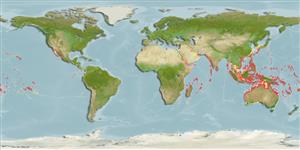>
Blenniiformes (Blennies) >
Blenniidae (Combtooth blennies) > Salariinae
Etymology: Ecsenius: Greek, exenios, -os, -on = uncontrolled, immoderate.
Eponymy: In Greek mythology, Midas was a king of Phrygia whose touch could turn anything to gold (a gift from the gods which had to be renounced once the impracticalities sunk in). The fish are named after him because of their golden coloration. (Ref. 128868), visit book page.
Environment: milieu / climate zone / depth range / distribution range
экология
морской ассоциированный с рифами; пределы глубины 2 - 40 m (Ref. 30874). Tropical
Indo-Pacific: Gulf of Aqaba and southeast coast of Africa to the Marquesan Islands.
Size / Вес / Возраст
Maturity: Lm ? range ? - ? cm
Max length : 13.0 cm TL самец/пол неопределен; (Ref. 2334)
Краткое описание
определительные ключи | морфология | морфометрия
колючие лучи спинного плавника (общее число) : 13 - 14; членистые (мягкие) лучи спинного плавника (общее число) : 19 - 21; колючие лучи анального плавника: 2; членистые (мягкие) лучи анального плавника: 20 - 23. Golden orange in color; black spot around anus; anterior part of dorsal fin with narrow dark margin (Ref. 4404). Indonesian form grey or greenish to golden-yellow. Tail long in adults (Ref. 48636).
Adults inhabit coral reefs (Ref. 9710), from clear coastal to outer reef walls, usually where currents are moderate (Ref. 48636). They swim 2 to 3 m above the benthos, feeding on plankton (Ref. 94105). During the orange-yellow phase, they are observed to school with Pseudanthias squamipinnis which they resemble in color. Individuals of Ecsenius midas can change color quickly from when on the bottom to swimming in open water to match the colors of the fishes they mix with (Ref. 48636). They also socially mimic their swimming behavior and also of Pseudanthias huchtii and Lepidozygus tapeinosomoa (Ref. 90102). Reported to feed on zooplankton (Ref. 37816). Oviparous. Eggs are demersal and adhesive (Ref. 205), and are attached to the substrate via a filamentous, adhesive pad or pedestal (Ref. 94114). Larvae are planktonic, often found in shallow, coastal waters (Ref. 94114). Minimum depth reported taken from Ref. 9710.
Life cycle and mating behavior
половая зрелость | размножение | нерест | икра | Fecundity | личинки
Oviparous, distinct pairing (Ref. 205).
Springer, V.G., 1988. The Indo-Pacific blenniid fish genus Ecsenius. Smithson. Contrib. Zool. (465):134 p. (Ref. 5296)
Статус Красного Списка МСОП (Ref. 130435: Version 2024-2)
Угроза для людей
Harmless
Использование человеком
рыболовство: коммерческий; аквариум: коммерческий
дополнительная информация
инструменты
Специальные отчеты
Скачать в формате XML
ресурсы в Интернет
Estimates based on models
Preferred temperature (Ref.
123201): 24.6 - 29, mean 27.7 °C (based on 716 cells).
Phylogenetic diversity index (Ref.
82804): PD
50 = 0.5000 [Uniqueness, from 0.5 = low to 2.0 = high].
Bayesian length-weight: a=0.00776 (0.00356 - 0.01695), b=3.00 (2.81 - 3.19), in cm total length, based on LWR estimates for this (Sub)family-body shape (Ref.
93245).
Trophic level (Ref.
69278): 2.6 ±0.29 se; based on food items.
устойчивость к внешним воздействиям (Ref.
120179): высокий, минимальное время удвоения популяции до 15 месяцев (Preliminary K or Fecundity.).
Fishing Vulnerability (Ref.
59153): Low vulnerability (10 of 100).
Nutrients (Ref.
124155): Calcium = 121 [60, 183] mg/100g; Iron = 0.735 [0.441, 1.221] mg/100g; Protein = 18.1 [17.0, 19.1] %; Omega3 = 0.0937 [, ] g/100g; Selenium = 28.6 [14.4, 58.5] μg/100g; VitaminA = 112 [34, 379] μg/100g; Zinc = 2.03 [1.38, 2.82] mg/100g (wet weight);
